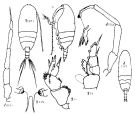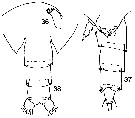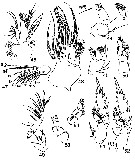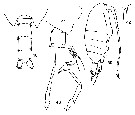|
|
 |
Fiche d'espèce de Copépode |
|
|
Calanoida ( Ordre ) |
|
|
|
Clausocalanoidea ( Superfamille ) |
|
|
|
Phaennidae ( Famille ) |
|
|
|
Xanthocalanus ( Genre ) |
|
|
| |
Xanthocalanus kurilensis Brodsky, 1950 (F,M) | |
| | | | | | | Ref.: | | | Brodsky, 1950 (1967) (p.230, figs.F,M); Minoda, 1971 (p.27); 1972 (p.325); Bradford & al., 1983 (p.71); Vyshkvartzeva, 2002 (p.98, figs.F,M) |  Issued from : K.A. Brodskii in Calanoida of the Far Eastern Seas and Polar Basin of the USSR. Opred. Fauna SSSR, 1950, 35 (Israel Program for Scientific Translations, Jerusalem, 1967) [p.231, Fig.142]. Female (from NW Pacif.): habitus dorsal and lateral left side); RVe, rostrum (ventral view); S1, P1; S5, P5. Male: habitus (dorsal); S5Le, left P5; S5Ri, right P5.
|
 Issued from : N.V. Vyshkvartzeva in Zoosyst. Rossica , St. Petersburg, 2002, 11. [p.99, Figs.36-38]. Female (from 44°35'N, 147°00'E): 36, forehead (lateral); 37, 5th thoracic segment with P5 and urosome (lateral); 38, same (dorsal). Nota: - Cephalosome and 1st pedigeroyus segment fused, 4th and 5th thoracic segments fused. - Rostrum as a short plate with 2 thin filaments. - Posterolateral corners of last thoracic segment produced, triangular, pointed, reaching just beyond middle of genital segment in lateral and dorsal view. - Urosome about as long as 1/4 of prosome. - Genital segment as long as wide, laterally without genital swelling, with a patch of setules just behind midlength of genital segment, just behind the genital opening. Spermatheca oblong oval, directed dorsad. - Urosomal segments 2 and 3 slightly longer than wide or thick. - Posterior margin of urosomal segments 1-3 striated. - Caudal rami as long as wide, with 4 long apical setae (seta 4 twice as long as seta 5) and short outer seta 2 and inner seta 7. - A1 24-segmented, reaching the middle of urosomal segment 2.
|
 Issued from : N.V. Vyshkvartzeva in Zoosyst. Rossica , St. Petersburg, 2002, 11. [p.100, Figs.44-54]. Female: 44, A2; 45, md palp; 46, Mx1 (without inner lobe 1); 47, Mx1 inner lobe 1 (another specimen); 48, Mx2; 49, Mxp; 50, P1; 51, P2; 52, P3; 53, P5 (dorsal side); 54, P5 (inner side); 55, P5; 56, P5 (another specimen). Nota: - A2 endopodal segment 2 with 6+8 setae; endopod as long as 2/3 of exopod; exopodal segments 1 to 6 with setal formula 0, 1, 1, 1, 1, 1+3, respectively. Md gnathobase with 10 teeth and 1 dorsal, slender, spinulose seta on cutting edge; basis with 3 inner setae; endopdal segment 1 and 2 with 2 and 9 setae, respectively; endopod as long as exopod. - Mx1: lobe 1 with 9 marginal, 4 tapering, with short spinules posterior (S11-S14), and 1 short, slender anterior setae (S6); inner lobe 2 with 2 long and 1 short setae; inner lobe 3 with 2 long and 2 shorter setae; inner lobe 4 with 3 long and 2 shorter setae; endopodal segment 1 fused with basis, endopodal segment 2 fused with the firsy, each with 2 very long and 1 short setae; endopodal segment 3 with 4 setae; exopod with 9 and outer lobe 1 with 7 long and 2 short setae. - Mx2 compact: inner lobes 1-3, short, subequal; inner lobe 1 with 5 setae (all plumose); inner lobe 2 with 2 long plumose and 1 shorter and more coarsely plumose setae: inner lobe 3 with 1 long plumose, 1 shorter plumose setae and 1 short worm-like sensory seta; inner lobe 4 with 1 long plumose, 1 shorter and more coarsely plumose setae, and 1 strongly sclerotized long seta with long, strong, dense spines; inner lobe 5 wiyj 1 strong claw-like seta furnished with about 50 strong, widely spaced spines, 1 not so strong claw-like and plumose seta and 2 worm-like sensory setae; endopod indistinctly segmented, with 7 brush-like and 1 worm-like sensory setae; brush-like setae slender, differing in length. - Mxp: Syncoxa with 1 plumose and 2 worm-like setae proximally, the latter bearing setules in proximal half; with 1 spinous seta and 1 brush-like sensory seta medially; and with 3 plumose setae subterminally; basis slightly longer than syncoxa; endopod as long as 2/3 of basis, with 2+4,
3, 3, 3+1 outer and 4 terminal setae, respectively. - P5 uniramous; 3-segmented; proximal segment as long as wide, with inner swelling, small spinules proximally and mre strong spinules distally along inner margin; 2nd segment about as long as wide, globular, with patches of spinules along inner margin and distal half of outer margin, and with a row of spinules on posterior surface; distal segment about as long as preceding, with spinules on posterior surface more abundant on one leg, with 4 serrate spines (inner the longest, outer spine as long as 2/3 of inner, situated opposite to the inner, 2 apical spines subequal.
|
 Issued from : N.V. Vyshkvartzeva in Zoosyst. Rossica , St. Petersburg, 2002, 11. [p.99, Figs.39-43]. Male: 39, habitus (lateral); 40, last thoracic segment and urosome (dorsal); 41, posterolateral corner of last thoracic segment and urosomal segments 1 and 2; 42, rostrum (frontal view); 43, P5. Nota: - Posterolateral corners of last thoracic segment slightly shorter than in female, triangular, pointed, reaching just beyond urosomal segment 1. - Rostrum with 2 more rigid than in female, tapering filaments. - Prosome 3.4 times as long as urosome; - Urosomes2-4 slightly longer than wide. - A1 reaching caudal rami, 21-segmented, 8-9th and 10-12th segments fused.
|
 Issued from : N.V. Vyshkvartzeva in Zoosyst. Rossica , St. Petersburg, 2002, 11. [p.101, Figs.59-69]. Male: 59, A2; 60, Md gnathobase; 61, Md palp; 62, Mx1; 63, Mx1 inner lobe1-inner lobe 3 (another specimen); 64, Mx2; 65, Mxp; 66, P1 (and endopods of both legs 1); 67, P2; 68, P3 (and apical spine of exopodal segment 3); 69, P4 (and apical spine of exopodal segment 3 of another leg). Nota: - A2 almost as in female, but coxa with a patch of setules on inner side. - Md with rudimentary gnathobase and wider than in female basis. - Mx1 and Mx2 smaller and more poorly sclerotized than in female. - Mx2 with inner lobes 1-3 small, subequal, with 5, 2, 2 slenderer setae, respectively; their armament rudimentary compared with that of female; inner lobe 4 with 1 short, naked, rudimentary seta, claw-like seta of female replaced by 1 strongly plumose, tapering seta; inner lobe 5 with 2 tapering, strongly plumose and 1 rudimentary setae. Distal endopodal complex with 1 distal, probably worm-like , seta the longest (its distal part seems to be missing), 1 greatly enlarged and 4 slenderer than in female, rudimentary brush-like setae, and 1 short rudimentary seta. - Mxp slightly slenderer than in female. Syncoxa with short, poorly sclerotized, probably worm-like seta, 1 short, thin brush-like seta about at midlength, and 1 distal subapical seta with thickened hairy basal and filamentous distal half and apically with patch of spinules. Basipod longer than syncoxa, slender, with elongate patch of spinules on inner margin proximally, slender medial setae and 1 longer distal seta with long spinules along proximal margin. Endopodal segment 1 with 2+4 long setae bearing long spinules along proximal margin; 3rd seta the longest; Endopodal segments 2-5 with 4, 3, 2+1, 4 tapering spinulose setae, respectively, outer seta short, reaching distal segment. - P1 to P4 as in female. -P5 slightly longer than urosome. Both legs uniramous, subequal in length, 5-segmented. Terminal segment of left leg very short, with 7 setules; subterminal segment with outer terminal spine and long thick inner subterminal spinulose process.
| | | | | Ref. compl.: | | | Yamaguchi & al., 2002 (p.1007, tab.1); Sedova & Grigoriev, 2005 (p.112); Ikeda & al., 2006 (p.1791, Table 2); Homma & Yamaguchi, 2010 (p.965, Table 2); Homma & al., 2011 (p.29, Table 2, abundance, feeding pattern: detritivores) | | | | NZ: | 1 | | |
|
Carte de distribution de Xanthocalanus kurilensis par zones géographiques
|
| | | | Loc: | | | NE Japan, Station Knot (44°N, 155°E), NW Pacif., Kamchatka, Kuril Is., Okhotsk Sea (off the Iturup Island), Bering Sea, S Aleutian Is. | | | | N: | 7 | | | | Lg.: | | | (22) F: 3,5; M: 3,3; (208) F: 3,52; (878) F: 3,4-3,5; M: 3,3; {F: 3,50-3,52; M: 3,30} | | | | Rem.: | 2000-3000 m (i Ikeda & al., 2006 (p.1799, Table 2) | | | Dernière mise à jour : 12/03/2015 | |
|
|
 Toute utilisation de ce site pour une publication sera mentionnée avec la référence suivante : Toute utilisation de ce site pour une publication sera mentionnée avec la référence suivante :
Razouls C., Desreumaux N., Kouwenberg J. et de Bovée F., 2005-2025. - Biodiversité des Copépodes planctoniques marins (morphologie, répartition géographique et données biologiques). Sorbonne Université, CNRS. Disponible sur http://copepodes.obs-banyuls.fr [Accédé le 12 décembre 2025] © copyright 2005-2025 Sorbonne Université, CNRS
|
|
 |
 |








